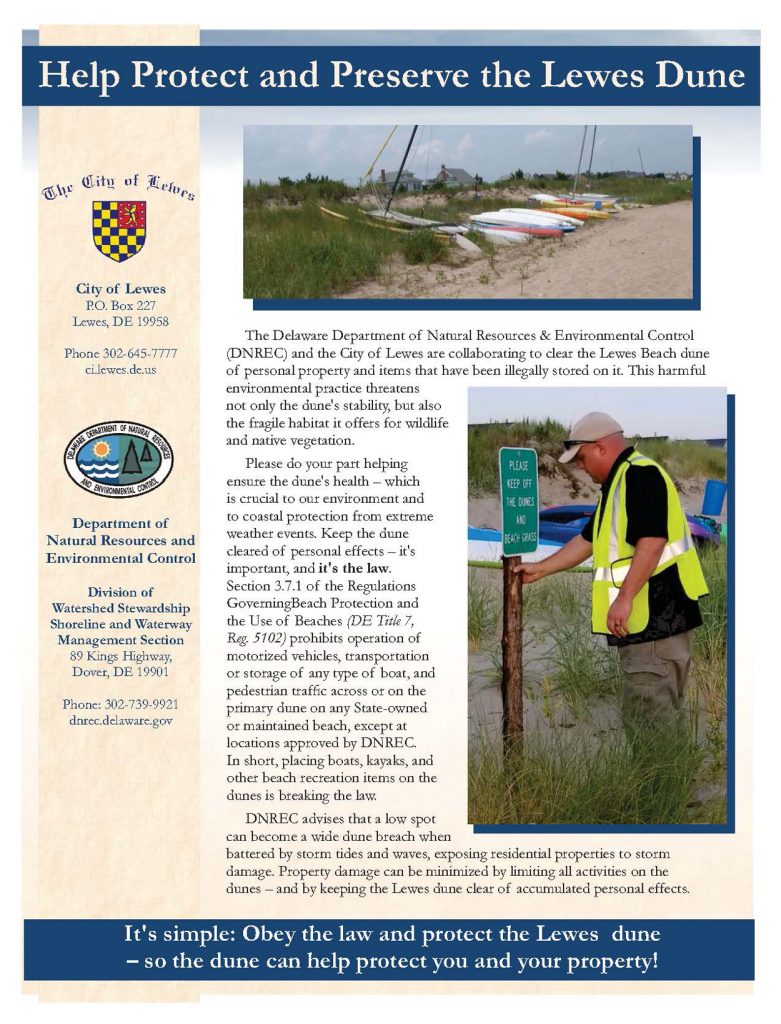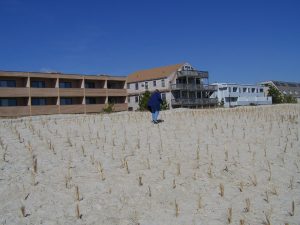Items stored on the dune can damage it, and the vegetation that helps hold it together.
DOVER – Delaware’s Department of Natural Resources and Environmental Control and the City of Lewes will launch an awareness campaign next week aimed at clearing the Lewes dune of personal effects such as boats and kayaks that are stored illegally on the dune – not only causing harm to the dune but preventing it from protecting coastal properties and from providing natural habitat for native wildlife.
 In collaboration with the city, DNREC’s Shoreline & Waterway Management Section within the Division of Watershed Stewardship will distribute a flyer advising against storing items such bikes, boats, kayaks and other water sports equipment on the dune. DNREC is mailing the flyer as a reminder to all Lewes property owners seaward of the canal in Lewes Beach – property owners within walking distance to the dune – that storing items on the dune is breaking the law in Delaware.
In collaboration with the city, DNREC’s Shoreline & Waterway Management Section within the Division of Watershed Stewardship will distribute a flyer advising against storing items such bikes, boats, kayaks and other water sports equipment on the dune. DNREC is mailing the flyer as a reminder to all Lewes property owners seaward of the canal in Lewes Beach – property owners within walking distance to the dune – that storing items on the dune is breaking the law in Delaware.
A second reminder to property owners and their guests is obeying another state law limiting pedestrian access and vehicle traffic on the dune. This law prohibits operation of motorized vehicles, transportation or storage of any type of boat, and pedestrian traffic across or on the primary dune on any state-owned or state-maintained public beach, except at dune crossing locations approved by DNREC.
The Shoreline & Waterway Management Section notes that for a dune to provide best protection for coastal properties, a continuous dune line needs to be maintained. A low spot in the dune can allow storm tides and waves to create a dune breach, exposing properties behind the protective dunes to storm waves. Structures, cars, trucks, bikes, boats, and other equipment placed in the dune area and heavy use of dunes by pedestrians for access to the beach can destroy vegetation and lower the elevation of the dune, thereby reducing the dune’s protection capabilities. Illegally storing manmade items, such as kayaks, boats or beach chairs smothers the beach grass that supports and helps sustain the dune. Without beach grass, sand is not trapped in the dune – and when sand is not trapped, it can be blown away by the wind, creating weak spots in the dune that can be breached by flood waters during coastal storms.
DNREC also has begun placing signage at Lewes Beach to remind beachgoers to stay out of the dunes, and will begin installing sand fencing in the same area where the signs are erected later in the season. For more information on dune protection, please contact DNREC’s Shoreline & Waterway Management Section at 302-739-9921 or the City of Lewes at 302-645-7777.
Media Contact: Joanna Wilson, DNREC Public Affairs, 302-739-9902
Vol. 49, No. 210
